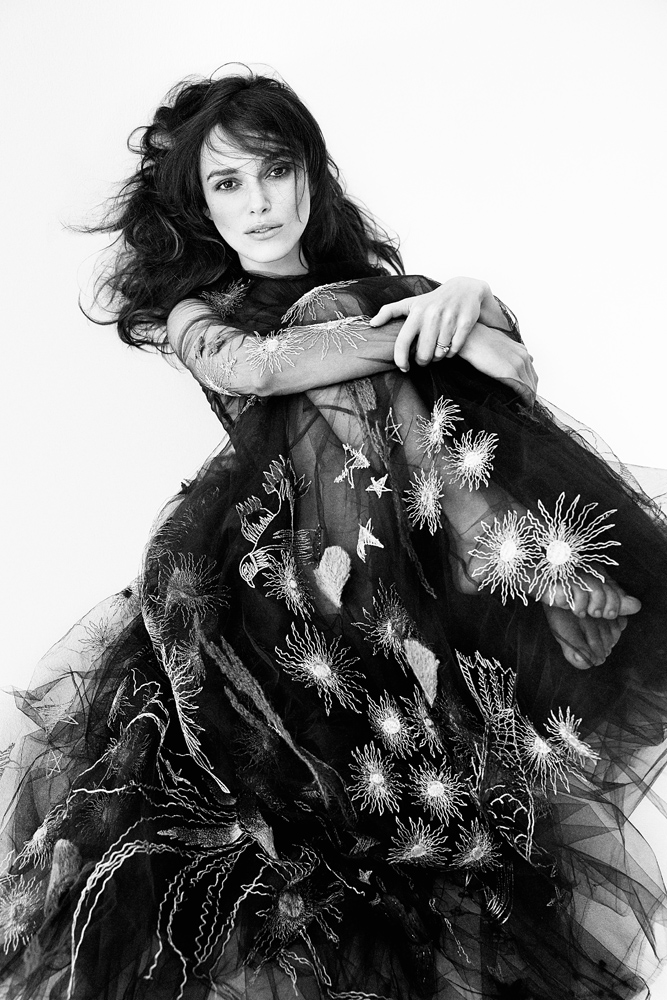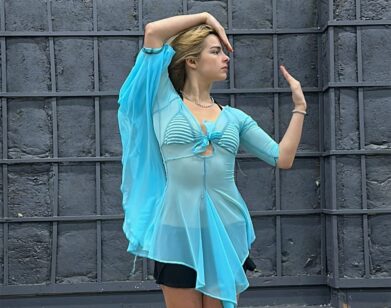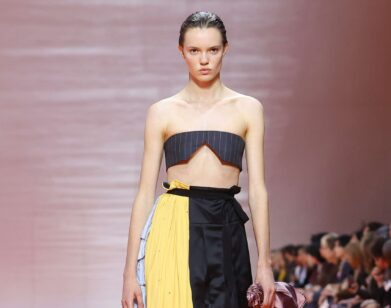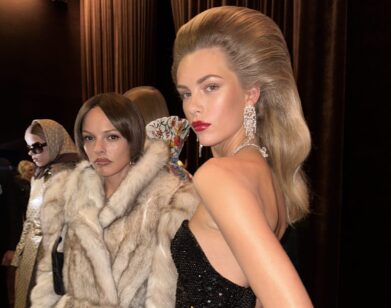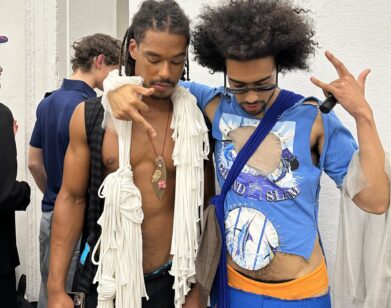Patrick Demarchelier by Keira Knightley
Things really go quickly with me . . . I like to be spontaneous and get a shot before the subject thinks too much about it. Patrick Demarchelier
Patrick Demarchelier was born outside of Paris in 1943, and any movie about his life would necessarily include the poignant scene of his stepfather giving the self-professed troublemaker an Eastman Kodak camera for his 17th birthday. After assisting the likes of Hans Feurer, the young Demarchelier struck out on his own, moved to New York, and developed his now signature, striking style of fashion photography. Destabilizing an elaborately staged fashion editorial or a portrait of Diana, Princess of Wales, for whom he was the official photographer, with a spark of spontaneity, Demarchelier creates a kind of verve, a frisson that has made him a legend, and his name a byword for fashion royalty—the very first thing Miranda Priestly wants to know of her hopeless new assistant in The Devil Wears Prada is “Did Demarchelier confirm?”
The Duchess (2008) star Keira Knightley knows a little something about onscreen royalty. In November she will appear alongside Benedict Cumberbatch in the WWII drama The Imitation Game, about the Enigma-code-breaking machine. Here, she tries to decode Demarchelier, getting the photographer to look at his life through the lens. Like the Devil‘s do-gooder assistant, she’s got Patrick.
KEIRA KNIGHTLEY: Hey, Patrick! How are you?
PATRICK DEMARCHELIER: Very good. I’m in Long Island on holiday. In a few days, I have a trip to Sweden. After that, I’m going back to New York for one day and then to St. Barts for a trip to work for a few days, then I’m finished.
KNIGHTLEY: Oh my God, you’re everywhere. Where are you going in Sweden?
DEMARCHELIER: We’re going to the north. It’s a hotel and spa. It’s on top of a tree.
KNIGHTLEY: On top of a tree? Is it the place where they have a box of mirrors, so you can’t see it? Have you been to this hotel before?
DEMARCHELIER: No, never. I’ve been to Sweden—my wife is Swedish—but this is a new place. How are you doing? Are you doing a movie now?
KNIGHTLEY: No, I’m not. What am I doing? I just bought a load of books that I’ll read over the summer and hopefully choose another film based on that. I don’t know if that’ll happen, but it’s quite a good way of working. Okay. I’m going to ask you questions. What’s your favorite picture that you’ve ever taken?
DEMARCHELIER: I don’t really think about that. For me, the new pictures are what I’m thinking about every day. The past is the past, no? Every day is a new challenge. Like for you, the movie that you’ll be in is a new challenge. Photography is just the shot—one day, two days—and the next day you’re gone.
KNIGHTLEY: Do you take pictures even when you’re not on shoots? Do you always have a camera with you?
DEMARCHELIER: Not too much, no. I don’t take the camera out with me. My eyes are the camera for me every day.
KNIGHTLEY: So does that mean if you’re walking around, you get inspiration, log it in your head, and maybe use it at some point?
DEMARCHELIER: Exactly. If you love it, it’s in your system.
KNIGHTLEY: What would be your ideal day, your dream day?
DEMARCHELIER: Every day is a dream, every day I spend with my wife.
KNIGHTLEY: Aw. Is it just fashion that you do?
DEMARCHELIER: No. I do fashion, portraits, nude. Sometimes animals, too. I love Africa. I love the wild. I love my dog. Actually, the best portrait I did was of my dog.
KNIGHTLEY: What sort of dog is it?
DEMARCHELIER: It’s a longhaired daschund. And it’s very funny, at a show in Paris, about six years ago—at the Petit Palais, the museum by the Champs-Élysées—there was a big show there, with a big picture of my dog, Puffy, like three meters high. [laughs]
KNIGHTLEY: What is your next show?
DEMARCHELIER: I’m doing a show in Tokyo, with Dior. I did a book for Dior haute couture three years ago, and I have a new book for them coming out in November. We’re doing a show in Tokyo with the pictures and the clothes mixed together.
KNIGHTLEY: How does it work, collaborating with a house like that? You have to keep the tradition but continue it moving forward, right?
DEMARCHELIER: They let me do what I want, basically. They give me the clothes and I do what I want. It’s a very interesting project.
KNIGHTLEY: You said something really interesting to me on the shoot: “You have to relax your face, because that’s what good movie acting is, a relaxed face. It’s the same thing as having pictures taken.”
DEMARCHELIER: The face is supposed to be relaxed. The more you relax …
KNIGHTLEY: You’re absolutely right. It’s very funny, because no photographer has ever said that to me before and made the kind of connection between the two things. You shoot digital, right? Do you still shoot on film as well?
DEMARCHELIER: Very rarely, only for special effect when I need it. Otherwise I don’t do film anymore.
KNIGHTLEY: I’ve noticed that the people who started on film still have the ability to see the person in front of them. Whereas for a lot of photographers who have only ever worked in digital, the relationship between the photographer and the person who they’re taking a picture of sort of doesn’t exist anymore. They’re looking at a computer screen as opposed to the person.
DEMARCHELIER: Exactly. I love digital, but the only problem is less intimacy. People look at the screen right away. Before, nobody saw the picture before you saw the final picture. There was more privacy in a way.
KNIGHTLEY: Does everybody then obsess about the image, suddenly trying to be perfect, as opposed to trying to capture a moment?
DEMARCHELIER: Yes. Now you work more like a team, with people who have good taste. It’s interesting. You can correct things, and if you don’t like an image right away, you can change it. Before you used to do a lot of pictures and pick a picture after. You can’t really compare; it’s a different way to work.
KNIGHTLEY: Would you ever go back to shooting on film, or do you think you’ve got to keep going forward?
DEMARCHELIER: Film is not very practical. The new world goes faster, and digital is very fast.
KNIGHTLEY: Do you miss any of the physicality of it? I think I’m a horrific kind of romantic about film. There’s something about that single shot that was one moment in time, and something about the physical process of the light hitting the lens and the dark room. I find it difficult to see the romance in digital.
DEMARCHELIER: It can do that too, actually. I do a Polaroid before shooting. A Polaroid you do one picture, three pictures, it’s really a moment. Capturing that moment with those pictures is interesting.
KNIGHTLEY: Your shoot the other day was probably the fastest photo shoot I’ve ever been on in my life, which was excellent. Have you always been really quick?
DEMARCHELIER: Ah. Things really go quickly with me. I like to do the pictures before people get too self-conscious. I like to be spontaneous and get a shot before the subject thinks too much about it. Sometimes it can be interesting to be very slow, so if you’re very, very slow, you get so bored that it’s interesting too. [laughs]
KNIGHTLEY: Who were the worst people to photograph?
DEMARCHELIER: Everybody can take a good picture. Everybody is interesting. Everyone has an interesting face. Some people are more difficult or more nervous or more tired. When you do a movie, you have action, you’re talking, you’re moving. You don’t see the camera. Taking a picture with a photographer, you don’t talk, it’s more difficult than in a movie for your body to relax, to be yourself.
KNIGHTLEY: Definitely. You’re looking for one moment that tells that story or whatever you’re trying to capture. Have you ever done film?
DEMARCHELIER: I do commercials sometimes. It’s funny because, for commercials, sometimes I work for a client and they say, “The model was not great.” In the moving image she was fine, but in the still photo it was difficult to get an image of her. It’s typical of doing a movie, because in the movie, you’re moving, you have personality, you don’t have to be great looking.
KNIGHTLEY: How did you come to your idea of beauty? Did you have idols when you were growing up, people whom you admired artistically?
DEMARCHELIER: Beauty is everywhere. And, no, my photography came naturally without any particular inspirations growing up.
KEIRA KNIGHTLEY IS A BRITISH ACTRESS WHO WILL STAR IN THE IMITATION GAME, OUT IN NOVEMBER.
For more from the Photographers’ Portfolio, click here.

